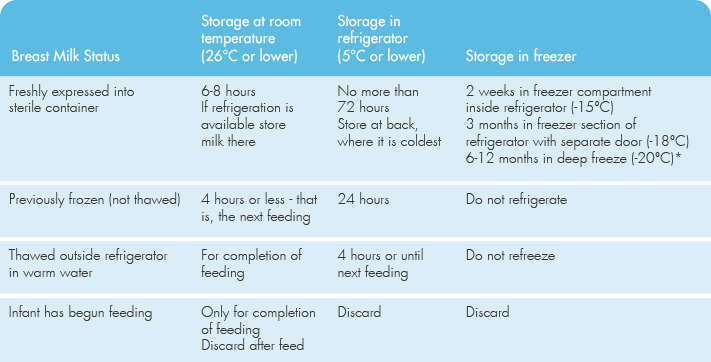Benefits of Breastfeeding
Breastfeeding is the most natural and biologically normal way to feed your baby, and a great help for mothers in learning to bond with their newborn. It is recommended for the first six to twelve months and beyond, and exclusive breastfeeding ensures that an infant receives the full nutritional and protective benefits of colostrum and breast milk. There are many reasons why breastfeeding is beneficial for both you and your baby:

- Breastfeeding your baby for the first six months of life helps strengthen the immune system, increasing your baby’s resilience against infection and disease.
- Breastfed babies find the nursing process soothing and comforting, meaning they are less likely to cry and become easily agitated. Infants enjoy the close contact with their mothers, and the process of suckling helps enhance the development of facial muscles that will later lead to developing speech.
- It is convenient and economical, also giving the mother a chance to sit down and rest during the day.
- There is no preparation required; the breastfeeding process is clean, safe and natural and has not been stored, treated or supplemented.
- Breast milk contains probiotics and omega 3 fats, which help support the baby’s growth, development and immune system.
- Colostrum (early breast milk) provides all the nutrition your baby needs right after birth, providing crucial protection against bacteria and viruses.
- Studies have found that full breastfeeding for six months boost’s baby’s resistance to respiratory illnesses such as pneumonia, wheezing and ear infections.
- Breastfeeding greatly reduces the risk of Sudden Infant Death Syndrome (SIDS), as well as other ailments such as diabetes, intestinal problems and food allergies.
- Breastfeeding can help the mother return to her pre-pregnant lifestyle, assisting in reducing the weight gained through pregnancy and enabling the uterus to shrink more quickly to its normal size.
- Breast milk is absorbed quickly into the baby’s system and is therefore less likely to cause stomach upset, constipation and diarrhoea.
How to Breastfeed & How Often
You’ll find that your new baby has a natural instinct, which will enable them to find their mother’s breast almost immediately birth. It is encouraged to allow your baby to suckle when they are first born, as the colostrum produced is extremely nutritious for your infant. Frequent feeding ensures your breasts are allowed to produce a steady supply of milk.
Don’t wait for your baby to cry to let you know it’s hungry. This is one of the later signs of hunger; instead look for your baby displaying the following signs:
- Bringing hands to the mouth.
- Turning their head to the side, searching for the breast.
- Chewing or sucking on hands or fingers.
- Making “uh, uh, uh” sounds.
- Sticking the tongue out or making suckling movements.
- Wriggling
It’s possible you may need to feed your baby every two to three hours in the first few weeks, however as they grow, so too will their stomach size, meaning they can take larger feeds less every three to four hours.
The length of feeding sessions will be different for every mother and baby, but for most babies who nurse eight to twelve times in twenty-four hours, a feed should last about thirty to forty minutes.
Step-by-Step Feeding Guide
- Start by finding a good, comfortable position to rest in, as you may be seated for a while. Make sure your back is supported and there are not too many distractions in the vicinity.
- Having your baby close to your skin will help regulate the baby’s body temperature to the mothers. Cradle them on their side, facing towards the breast, with their head supported close to the nipple. Let their head tilt back slightly, as this will help them to nurse easily.
- Hold your breast if you need to, and lift your baby so their nose is at the level of your nipple. As they are searching for the nipple, your baby might bob their head around or suck at their fist. This is normal behaviour so don’t hurry them – they will soon realise this isn’t the breast and continue searching with their mouth.
- Your baby should be able to latch on fully to the breast, with their mouth covering most of the areola. Once they are taking deep, strong sucks, you can relax the hand holding your breast and smoothly switch cradling positions to sit more comfortably.
- If you feel your baby spends too much or not enough time nursing, or if there is any pain or discomfort, we recommend you contact your GP or infant health professional for advice. Support and advice from other breastfeeding mothers is also valuable.

Expressing and Storing Breast Milk
There may be occasions when it is not practical for you to feed your baby breast milk directly from the breast, and that is when it is suitable to express your breast milk. There are a few techniques you can use to stimulate your let-down reflex (the act of hormones triggering the release of breast milk). These include:
- Warmth, either from having a shower beforehand, having a warm drink or placing warm face washers on the breast for a few minutes before expressing.
- Gently massaging your breasts by stroking down towards the nipple or lightly rolling the nipple between your fingers. Whilst you can’t actually ‘push’ milk out of the breast, this will help stimulate the let-down reflex.
- Being close to or thinking about your baby will also assist triggering the let-down reflex.
- Follow the directions of either your hand pump or electric pump for best results.
You can express as much or as little milk as you like, as this is relative to the reason for expressing. If it is to relieve pressure, sometimes only a little is needed. If you are expressing for your baby, you may need to express fully and frequently. Some mothers will find that they are able to express quite large volumes of milk every few hours, and some will find it easier to express several smaller amounts (e.g. up to 30ml).
Refrigerate or freeze milk after expressing, and date the container at the time of collection to ensure the freshest milk is used. Freeze any milk that won’t be used within two days.
Length of time breast milk can be stored

Common Problems
Breastfeeding can be associated with many common problems, particularly in the early days of establishing breastfeeding. Most are temporary, related to positioning and attachment, and can be managed by the mother without discontinuing breastfeeding. Some, however, may require medical support from your health professional.
Common problems to look out for include:
- Sore nipples
- Nipple infections
- Engorged breasts
- Mastitis
- Sucking Difficulty
- Not gaining weight
- Blocked ducts
Nipple pain especially is a very frequent occurrence, which most women will experience in the initial few days of breastfeeding. A common treatment for nipple pain is a warm water compress, and avoiding using shampoos, soaps and lotions on the nipple will significantly reduce the likelihood of soreness and infection. It is one of the main reasons for ceasing breastfeeding, so ensure you take the time to assess your positioning and attachment technique to avoid ongoing discomfort.
When Breastfeeding Doesn’t Work
While most women endeavour to breastfeed their child, sometimes, for a variety of reasons, it doesn’t work out. It can be distressing for a mother when she isn’t able to breastfeed, but it is also very common and not abnormal in any way. Fortunately, infant formulas such as CREATIVE’s Gold, Platinum and Gold Diamond range are the perfect alternative, scientifically proven to be a high quality and nutritious substitute to a mother’s natural breast milk. Our infant formula range can also be used in combination with breast milk, so your child receives the best possible nutritional intake.
